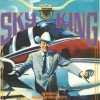
Sky King was an American radio and television series. Its lead character was Arizona rancher and aircraft pilot Schuyler "Sky" King.
King and his niece Penny (and sometimes her brother Clipper — first season only) lived on the Flying Crown Ranch, near the fictitious town of Grover, Arizona. Penny and Clipper were also pilots, although they were inexperienced and looked to their uncle for guidance. Penny was an accomplished air racer, rated as a multiengine pilot, whom Sky trusted to fly the Songbird.
The radio show began in 1946 and was based on a story by Roy Winsor, the brainchild of Robert Morris Burtt and Wilfred Gibbs Moore, who also created Captain Midnight.
"Radio premiums" were offered to listeners, as was the case with many radio shows of the day. For example, the Sky King Secret Signalscope was used on November 2, 1947, in the "Mountain Detour" episode. Listeners were advised to get their own for only 15 cents and the inner seal from a jar of Peter Pan Peanut Butter, which was produced by the sponsor, Derby Foods. The Signalscope included a glow-in-the-dark signaling device, whistle, magnifying glass, and Sky King's private code. With the Signalscope, one could also see around corners and trees. The premiums were innovative, such as the Sky King Spy-Detecto Writer, which had a "decoder" (cipher disk), magnifying glass, measuring scale, and printing mechanism in a single package slightly over two inches long. Other notable premiums were the Magni-Glo Writing Ring, which had a luminous element, a secret compartment, a magnifier, and a ballpoint pen, all in the crown piece of a "fits any finger" ring.